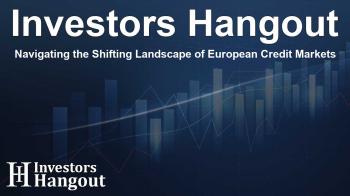Navigating the Shifting Landscape of European Credit Markets

Understanding European Credit Markets
In recent discussions, many have highlighted the significant progress in European equities, which have surged to unprecedented highs due to several bullish factors. These include attractive valuations, supportive monetary policies, evolving geopolitical conditions, and vital reforms.
Similar Trends in Credit Markets
However, it's important to note the parallel bullish trend in European credit markets that is often overlooked. Just as in the U.S., European High Yield Credit Spreads have been consistently narrowing, reaching new lows. Unlike the United States, which has revisited pre-2008 lows, Europe is on a similar trajectory, indicating a strong bottoming process.
The Implications of Narrowing Credit Spreads
On the surface, tightening credit spreads signal investor confidence in the economic landscape. This reflects a willingness to accept credit risk, suggesting that borrowers can access capital at lower costs, facilitating more vibrant financing conditions.
Feedback Loops in Financial Markets
This improvement creates a reassuring feedback loop: as financial conditions ease, growth and optimism increase, which in turn bolster risk assets. Such dynamics can foster a climate of optimism within equity markets, enhancing the overall economic sentiment.
Balancing Optimism with Caution
Yet, this environment may also breed overconfidence. Historically, narrow spreads do not persist for extended periods. Lingering uncertainties about the macroeconomic outlook, heightened geopolitical tensions, and the potential resurgence of inflation all contribute to a cautious sentiment among investors.
Equities Versus Credit Risks
When evaluating investment choices, the risk premiums available in equities are substantially more favorable than those found in credit markets. In the event of an inflation spike or interest rate increase, equities are likely to withstand shocks more effectively than credit instruments, making them an attractive option for investors.
Staying Informed and Proactive
In light of these developments, it's crucial for investors to monitor the situation closely and to maintain a bullish outlook on European equities. Being aware of shifts in credit spreads can serve as a valuable indicator for future market movements.
Exploring Emerging Market Dynamics
It's not just Europe and the U.S. experiencing these credit trends; emerging markets (EM) are also seeing a decline in corporate credit spreads, signaling a wave of investor complacency. While this trend often correlates with improved fundamentals amid a calm macroeconomic backdrop, it carries its own set of challenges.
Evaluating Risk Premiums in EM Investments
Investing in EM sovereign bonds, excluding China, and EM equities, where higher risk premiums are available, may provide better growth prospects. This strategy allows investors to pursue asymmetric upside potential while being mindful of the risks posed by corporate bonds.
Recognizing Key Developments
Overall, the recent trends in credit markets represent critical developments, albeit ones that may have gone unnoticed by many. Investors must stay vigilant to navigate these changing environments effectively.
Frequently Asked Questions
What are European credit markets currently indicating?
European credit markets are showing narrowing high-yield credit spreads, indicating investor confidence and low borrowing costs.
How do credit spreads affect equity markets?
Narrowing credit spreads can boost equity market sentiment as easier financial conditions support growth and risk-taking.
What should investors focus on amidst market optimism?
Investors should remain cautious of overconfidence and keep an eye on macroeconomic uncertainties while being bullish on equities.
Are emerging market investments a viable option?
Yes, focusing on EM sovereign bonds (excluding China) and EM equities can offer better risk premiums and growth opportunities.
What other factors should be considered in the current investment landscape?
Investors should consider geopolitical tensions, inflation risks, and the overall macroeconomic environment when making decisions.
About The Author
Contact Olivia Taylor privately here. Or send an email with ATTN: Olivia Taylor as the subject to contact@investorshangout.com.
About Investors Hangout
Investors Hangout is a leading online stock forum for financial discussion and learning, offering a wide range of free tools and resources. It draws in traders of all levels, who exchange market knowledge, investigate trading tactics, and keep an eye on industry developments in real time. Featuring financial articles, stock message boards, quotes, charts, company profiles, and live news updates. Through cooperative learning and a wealth of informational resources, it helps users from novices creating their first portfolios to experts honing their techniques. Join Investors Hangout today: https://investorshangout.com/
The content of this article is based on factual, publicly available information and does not represent legal, financial, or investment advice. Investors Hangout does not offer financial advice, and the author is not a licensed financial advisor. Consult a qualified advisor before making any financial or investment decisions based on this article. This article should not be considered advice to purchase, sell, or hold any securities or other investments. If any of the material provided here is inaccurate, please contact us for corrections.

